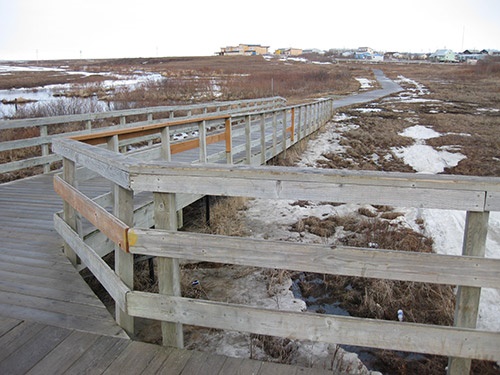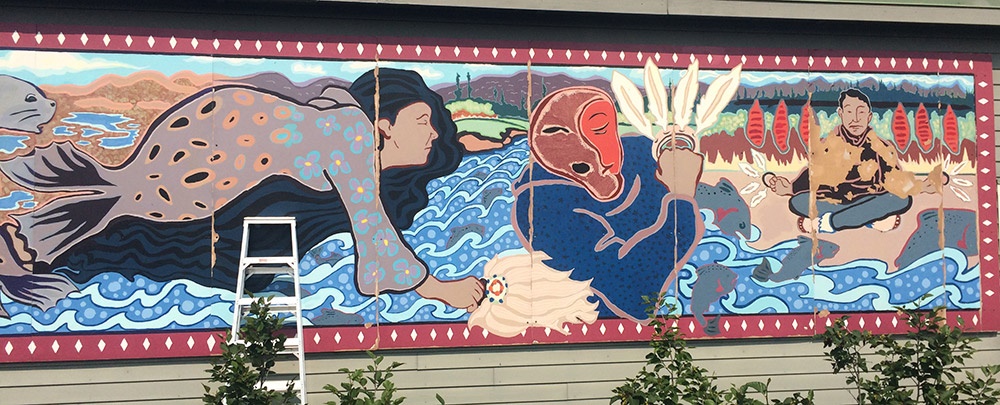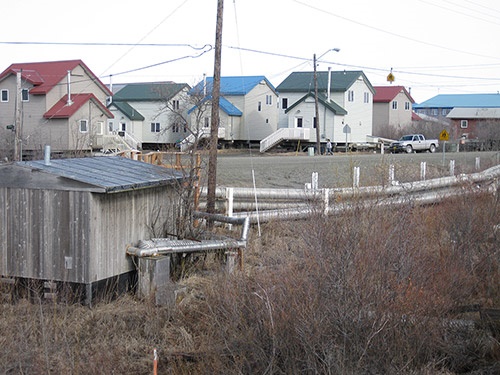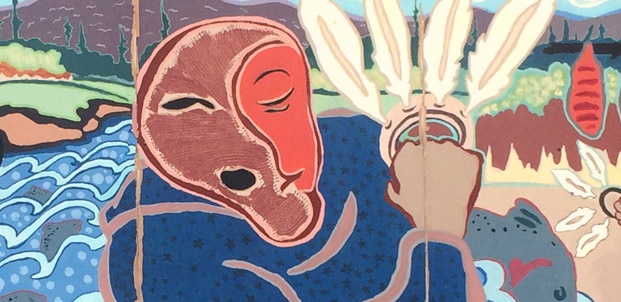There are no roads to Bethel, Alaska. That's the case for many villages that are considered "rural" in this wilderness state, and that means that housing can be complicated. For Bethel, population 6,500, the need for housing has become more critical in recent years, and a NeighborWorks organization is trying to help.
Bethel is 62% Alaska Native and is surrounded by 56 villages which are 94% Alaska Native, says Jim Nordlund, executive director of NeighborWorks Alaska. Bethel is also home to a new hospital, the Yukon-Kuskokwim Health Corporation, and an airport. The town also features a sled dog race, a museum and a dance festival.
 When a new home is built, says Nordlund, the construction materials have to come by way of barge before the Kuskokwim River freezes. If the order doesn't make it, there are no supplies until late spring. "The timing of everything is really critical," Nordlund says. And housing is expensive for the Alaska Natives who are building some of those needed homes.
When a new home is built, says Nordlund, the construction materials have to come by way of barge before the Kuskokwim River freezes. If the order doesn't make it, there are no supplies until late spring. "The timing of everything is really critical," Nordlund says. And housing is expensive for the Alaska Natives who are building some of those needed homes.
Nordlund's organization set off with a grant from NeighborWorks to see if they could find a way to leverage dollars and help the housing situation in Bethel. Based in Anchorage, they did not want to be seen as interlopers, Nordlund says, so they reached out to the Orutsaramiut Native Council to see if help would be welcome. The answer was "yes," though Calvin Cockroft, tribal housing director with the ONC says he was hesitant at first.
"We're a very small operation here," says Cockroft. "There are only three people in our office and there's only so much we can do." He was already administering several programs, he says, "and I had my head down. I was new to my position and worried about administering the programs I already had. I never had a chance to think out of the box and come out with new ways to address housing. That's how our partnership opened my eyes."
The tribes receive funding through the Native American Housing Assistance and Self Determination Act of 1996 (NAHASDA) for home building. Often, Nordlund says, they build homes one at a time, not enough to keep up with demand in Bethel. And while prices are reduced for the homes' occupants, the subsidies are such that the ONC doesn't recoup its funding.
 After a year of research, teaming with Agnew:Beck, NeighborWorks Alaska made the recommendation that the Council use their NAHASDA funding to build fourplexes in a platted subdivision, which has already received additional funding for the local roads from the Indian Community Development Block Grant (ICDBG). If one of the four units goes to an Alaska Native, he says, they can rent the other units to people paying market price, giving the ONC enough of a return to move forward with other housing projects. "We've been promoting this idea of having the NAHASDA money go farther," Nordlund says. "But we're not the decision makers. We have grant money invested, but not equity."
After a year of research, teaming with Agnew:Beck, NeighborWorks Alaska made the recommendation that the Council use their NAHASDA funding to build fourplexes in a platted subdivision, which has already received additional funding for the local roads from the Indian Community Development Block Grant (ICDBG). If one of the four units goes to an Alaska Native, he says, they can rent the other units to people paying market price, giving the ONC enough of a return to move forward with other housing projects. "We've been promoting this idea of having the NAHASDA money go farther," Nordlund says. "But we're not the decision makers. We have grant money invested, but not equity."
It is the ONC in this case, that has the equity. Cockroft says his organization normally builds four houses each year. But after meeting with NeighborWorks Alaska and other consultants, he realized those four houses wouldn't make the impact needed in Bethel.
 NeighborWorks Alaska invited Cook Inlet Housing Authority to work with them and the ONC Tribe to explore possible leveraging opportunities that would help them increase their annual production of housing. Cook Inlet Housing is also a Community Development Financial Institution (CDFI) that delivers HUD 184 loans, specifically designed for American Indian and Alaska Native families.
NeighborWorks Alaska invited Cook Inlet Housing Authority to work with them and the ONC Tribe to explore possible leveraging opportunities that would help them increase their annual production of housing. Cook Inlet Housing is also a Community Development Financial Institution (CDFI) that delivers HUD 184 loans, specifically designed for American Indian and Alaska Native families.
Specifically, Cook Inlet Housing has constructed four-plex rental homes using the HUD 184 loan guarantee program to provide workforce housing for Alaska Native people living in Anchorage. Traditionally, HUD 184 loans loans are used to acquire or build single family homes, says Carol Gore, Cook Inlet's president and CEO. But they've been piloting a fourplex model to address workforce rental housing for Alaska Native households and others who are essential to the community. This allows non-Native households who pay market rent to occupy one or more of the units. In return, Cook Inlet Housing is able to provide rental homes to those Alaska Native households that are below or higher than the 80% of Area Median Income that is required by HUD in other housing programs. This blurring of the income line streamlines the eligibility while allowing those households who are just over 80% of area median income to find affordable housing.
Gore believes a similar project could work in Bethel, where there's a housing shortage, to build critical housing for hospital workers, school teachers and village safety officers. That would help the ONC help attract and retain those who are essential to their community while providing more housing for their own tribal members.Because of permafrost, houses in Bethel are built on pilings. The weather is harsh with cold winters and strong winds so the construction of the homes is different than in Anchorage. But the theory is the same – finding a way to increase supply of housing that is financially viable. "They have a different environment," Gore says. The ONC Tribe has the expertise to build in their environment, and NeighborWorks along with Cook Inlet Housing brought leveraging experience to provide new ideas to increase the supply of much needed housing.
"If you're a tribe and you're used to using only Indian housing block grants, you think that if you leverage it with something else, you fear you're not meeting your mission or serving your people," Gore says. "This helps them use other money to also serve their people. It's just a different thought process."
Bethel has a high poverty rate, and the region faces challenges. "They've been doing amazing things," Gore says. "But they're hungry to do more." Her organization, with four-plexes that house Alaska native people and those who are essential to the community, provided the example.
Cockroft says in the past, the ONC has used NAHASDA funding, but hadn't found a way to leverage funding and reinvest it; they didn't realize the opportunity that program income gave to Tribes. Now they're looking at creative ways to stretch those dollars. "Now I realize it's a golden egg and should be treated that way," he says. "We're saving it and building it and waiting for the right opportunity to invest."
Shanna Zuspan, principal at Agnew:Beck, an Anchorage consulting firm, says her organization has had a long history working with tribal communities. Their research found that there was a strong market demand for housing in Bethel, she says, and the fourplex idea could offer a positive cash flow to the ONC.
.
"The current model is to build three or four single family units a year using their NAHASDA allocation." This model looks to serve Tribal members and provide market-rate housing and program income to ONC, Zuspan says. With the fourplexes, there is still a financing gap but over time ONC could grow their program income to be able to provide an even larger impact in Bethel. The community also needs an investment to extend piped water and sewer, built above ground rather than disrupting the permafrost.
Zuspan shared strategies for bringing funding together and using NAHASDA money as part of a financing package. "We're honing that strategy and design and trying to figure out how to secure additional grant money investment to get achieve more clarity on costs and design," she says. "We're offering technical assistance."
Many places in Alaska are in similar situations when it comes to housing costs and needs, Zuspan says. "But the situation in Bethel is more magnified. In some ways it's no different from other parts of America where there's a need for new housing. But we're dealing with a remote location, and the housing market, even in urban parts of Alaska, is not functioning super well."
The region around Bethel is designated as being in persistent poverty, defined as an area where 20% or more of the population has lived in poverty, as defined by the Census, for 30 years. But the region also has doctors, nurses and other professionals who could afford more housing. Nordlund says the projection is that Bethel will need 500 more housing units over the next 10 years.
"They're big challenges," Nordlund says. "But they're not impossible to overcome. We wouldn't be doing this work if it were impossible." If the project is approved, it may begin as soon as next summer, as long as they catch the barge.
Meanwhile, NeighborWorks Alaska has been using a grant from Enterprise Community Partners to investigate piping water and sewage above ground for the new subdivision, rather than the "haul" system that is popular in much of Bethel. About 75% of the population uses the haul method, Nordlund says, which means that they try to conserve water between deliveries. That had an effect on health, even before the pandemic. The pipe system costs more up front, but it would save money over the years, Nordlund says. They're currently working on a paper as they discuss options with the ONC and the city of Bethel.
Cockroft says the ONC has received a grant to design the fourplex; now they're seeking another grant to help build it. His goal, he says, is the same as NeighborWorks Alaska's goal: "to provide safe, sanitary housing to our region."
Further reading:
A NeighborWorks organization formed a unique partnership with the Tule River Tribe to create 'Village of the Cousins.'
Native American Community Development is often a part of NeighborWorks training courses.
11/23/2020

